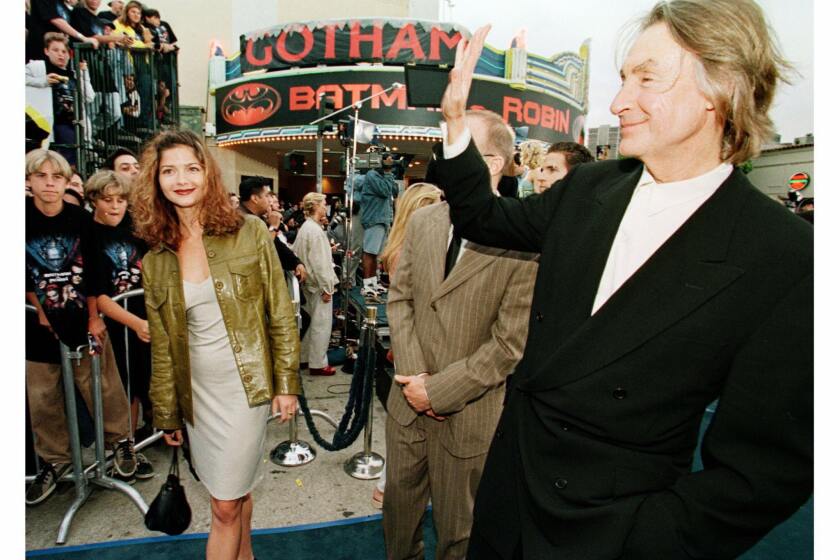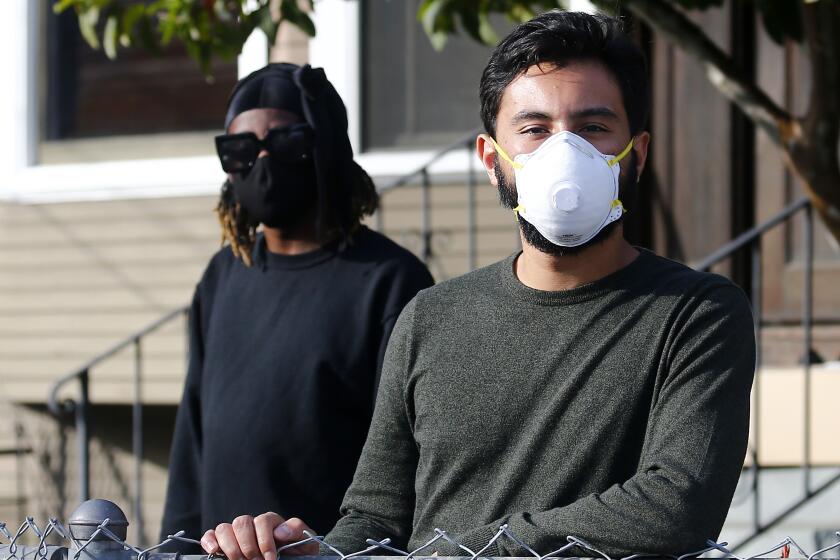Joel Schumacher’s ‘St. Elmo’s Fire’ understood how friends save us, even from ourselves
- Share via
Joel Schumacher, who died on Monday, may be remembered by many as the director who “ruined” Batman. Certainly “Batman and Robin,” the disastrous follow-up to his well-received “Batman Forever,” is considered a low point in the franchise (and in star George Clooney’s career).
But Batman appears to have recovered nicely — and rubber nipples on the Bat Suit was nothing compared to Schumacher’s most enduring legacy: the Era of the Friend Group, or the myth of “St. Elmo’s Fire.”
The story of seven white, middle- to upper-class college friends struggling through the year after graduation, “St. Elmo’s Fire” was panned by most critics and adored by a very large audience, no doubt in part because it hit so many contemporary cultural notes.
Co-written by Schumacher and Carl Kurlander, “St. Elmo’s Fire” was released in June 1985, just before media fascination with young urban professionals was about to enter backlash mode, and it was a High Yuppie event, down to Judd Nelson’s button-down-and-suspenders look and the opera-length pearls Ally Sheedy somehow managed to continue wearing while having a lot of sex, including at one point in the shower. Working off the white college-centric nostalgia of “The Big Chill” (1983), “St. Elmo’s Fire” harnessed the youthful energy (and several cast members) of “The Breakfast Club,” which had debuted a few months earlier, thereby solidifying not only the notion of a specific Hollywood Brat Pack but the idea of brat packs in general.
Even for those entranced by the self-involved and self-destructive Bolivian beat of “Bright Lights, Big City,” (Jay McInerney being a founding member of the literary Brat Pack), “St. Elmo’s Fire” offered a less grim alternative: the relatively new notion that friend groups could save us, even from ourselves.
Adult friends were, in fact, the new, improved family.
Film director Joel Schumacher, whose varied work included such movies as ‘St. Elmo’s Fire,’ ‘The Client,’ ‘Batman Forever’ and ‘Falling Down,’ died in New York City on Monday morning. He was 80.
Now, there was a lot going on in 1985 — AIDS, New Coke, Mikhail Gorbachev, the movie version of “The Color Purple,” Madonna, Martina Navratilova, Whitney Houston, Nintendo, the Unabomber — but it is impossible to overstate the impact “St. Elmo’s Fire” had on American culture.
Not only did it showcase a Brat Pack-plus cast with a post-Georgetown sheen but it kicked “coming of age” into the early 20s, where it has stayed ever since.
The line “I never thought I would be so tired at 22,” uttered by Demi Moore’s fast-lane car crash of a character, Jules, became a mantra for those young adults, from the tail end of the Baby Boom to the older members of Gen Z, who realize to their chagrin that “adulting” is hard.
This realization, which some older people inevitably refer to as “whining,” explains, in part, some of the film’s negative reviews.
I, on the other hand, knew exactly what Jules meant, then and now. For many women, keeping up appearances is very important, especially when it comes to work and independence; in 1985, it was not unusual for a woman expressing a feeling of being overwhelmed to be dismissed with: “Well, you wanted to have a career.”
I graduated college in 1985 and began that career in the city (albeit New York rather than D.C.) — which means “St. Elmo’s Fire,” including and especially its “Man in Motion”-led score, is burned forever into my psyche. For one thing, I wanted all of Demi Moore’s bracelets. For another, I was not used to seeing contemporary films show even the remotest interest in anything about me as a young woman beyond my Hollywood-designated desire to find love.
And while the lineup of all-white archetypes, with their living-beyond-their-means domiciles and wardrobes, was more than occasionally irritating, the gang’s regular swings between fear and exhilaration, fury and adoration, rang unnervingly true.
Critic Lorraine Ali writes of seeing her immigrant upbringing in the San Fernando Valley reflected in the Mindy Kaling Netflix comedy ‘Never Have I Ever.’
More important, the film accepted, as its premise, the often inexplicable importance, resilience and high drama of friendship. Several reviewers at the time dinged the film for never explaining why this particular assortment of people were friends, which meant that, to a certain extent, they missed the point. Friend groups are not orchestrated; they occur through random addition, like free-form Lego structures. Those that survive become units to be preserved, as a safety net — independence for many of us being a group activity — but also, like family, for the sake of the unit itself.
Maybe the group in “St. Elmo’s Fire” began with Leslie (Sheedy) and Jules being assigned as roommates freshman year, or Kevin (Andrew McCarthy) and Alec (Nelson) meeting in the Young Democrats. But that really doesn’t matter. What matters is the familial roles they have assumed — Rob Lowe’s scrapegrace, Sheedy’s and Nelson’s parental units, Mare Winningham’s good girl — and how the group moves as one, both functionally and dysfunctionally.
The scenes in which the group swarms to rescue, reconcile and, finally, say farewell to one of its members offered both hope and recognition of a new reality, particularly for women. As much as we may still swoon over Jane Austen, young women no longer move from childhood to adulthood by way of marriage, and the fear of the big city, or simply striking out on one’s own, was assuaged by the existence or prospect of a new familial unit made up of friends.
All of which which is, I admit, a lot to lay on a movie that relied more on the innate charm of its cast than its script — and Schumacher’s talent for casting, especially in “St. Elmo’s Fire,” “The Lost Boys” and “Flatliners,” is his most obvious influence on the entertainment industry.
But the roiling biosphere of “St. Elmo’s Fire’s” young-adult friend group took on an omnivorous life of its own.
Suddenly friends were the mainstay not only of high school but of young-adult life. “Thirtysomething” may have been a direct echo of “The Big Chill,” but the cascade of young-adult pods in film — from “Four Weddings and a Funeral” to “The Hangover” — and television — “Friends,” “Grey’s Anatomy,” “Happy Endings,” “The Mindy Project” — all have “St. Elmo’s” DNA.
“Seinfeld” satirized it, “The Big Bang Theory” geekified it and “Sex and the City” womanized it, but for several decades, television all but ignored the family in favor of “learning to adult together” comedies and dramas.
The culture, meanwhile, leaned heavily into the idea that learning to adult never ends and that friends are the family you choose.
As the coronavirus pandemic become grimmer, young people are considering moving home with their parents and extended family. But that presents risks.
The good news? Blood is not necessarily thicker than water — sometimes water can be pretty darn thick, especially as people are allowed to be defined by characteristics other than marital or romantic attachments.
The bad news? The mythology of the friend group implies that if we have one, none of us need ever feel lonely, adrift or isolated, which is absurd and unhelpful. As with love, sports and urban housing, reality often falls very short of the camera-ready expectations — leaving those of us without a squad, a crew or a movable-brunch group of super-cool long-term friends to wonder where we’ve gone wrong. And any group of humans can become tyrannical, or even toxic, especially over time.
Did friend groups exist before “St. Elmo’s Fire”? Of course they did. But historically, coming-of-age tales skewed younger — high school or college — and while young men and women might accidentally become friends while on a mutual quest, the core friendships of young adulthood were all male or all female (with members of the opposite sex seen as threats to the collective).
For all its glaring lack of diversity (seriously, the only person of color is a prostitute), its more than occasional cheesiness and the now-horrifying subplot of Emilio Estevez stalking Andie MacDowell, “St. Elmo’s Fire” offered a revolutionary image of adulthood.
Success is not defined by the big wedding or winning the fight or finding personal acclaim. Instead, it’s achieved by learning to act in good faith as one among many.
After all, even Batman joined the Justice League.
More to Read
The biggest entertainment stories
Get our big stories about Hollywood, film, television, music, arts, culture and more right in your inbox as soon as they publish.
You may occasionally receive promotional content from the Los Angeles Times.













